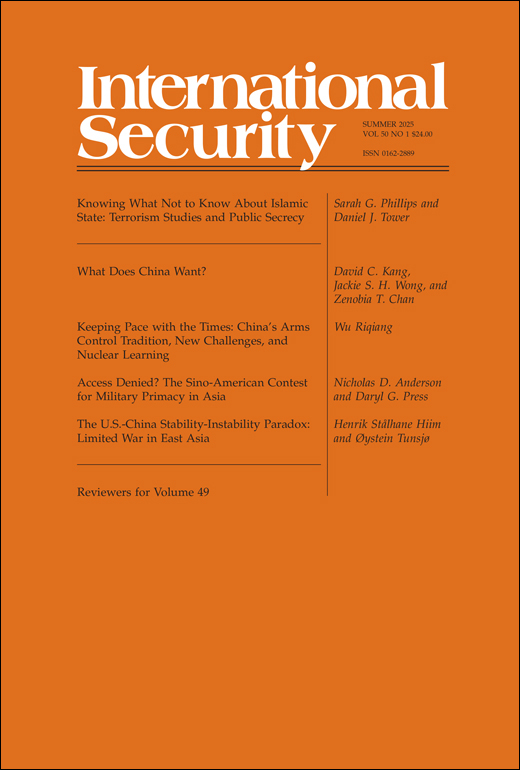
作者/Author(s): Henrik Stalhane Hiim and Oystein Tunsjo
網站來源/Source: International Security, Vol. 50, No. 1
日期/Date: 夏季/2025
關鍵字/Keywords: 戰爭、地理、科技、美中
摘要:
「穩定—不穩定悖論」指出,有限戰爭在當今東亞爆發的可能性,比冷戰時期的歐洲更高。
- 冷戰時期的歐洲
- 歐洲境內缺乏天然屏障,導致衝突更容易擴散或傷及平民。
- 美國與北約相信自己的軍事技術優勢比蘇聯更強大,能打贏有限戰爭,但對於能否徹底改變軍事戰略、獲得決定性優勢,依舊抱持懷疑態度。
- 美蘇雙方都理解在歐陸戰場升級衝突的風險與代價,也會懷疑自身能否有效遏制陸戰。因此雙方在相互挑戰時相對克制,反而降低了有限戰爭的風險。
- 當前東亞局勢
- 因為中國有廣闊的陸上邊界作為緩衝,因此美中之間若爆發常規戰爭,較有可能發生在海上而不是陸戰。水域則成為美國盟友的天然屏障,讓美國更容於保護地區盟友,避免中國發動大規模海上入侵。然而,水域作為天然屏障的特點,也意味著若中美間爆發常規戰爭,能更有效地限制衝突範圍並減少平民傷亡。
- 與冷戰時期相比,美中在 ISTAR(情報、監視、目標獲取與偵察任務)以及C2(指揮與管制)能力皆有提升。如今美中雙方具備更強的戰場掌控力,並仰賴無人軍事系統,在精準打擊目標的同時,有效控制軍民傷亡。
- 依此邏輯,在東亞爆發有限戰爭的風險,高於冷戰時期的歐洲。即便無法達到顯著的軍事成效,美中仍可能小心避免跨越升級紅線。
- 中國軍事規劃者相信,他們能憑藉地理因素,限制戰爭範圍,專注於「打得贏的局部戰爭」。近年美方的兵棋推演同樣顯示,美國規劃在台海與中國展開有限戰爭。
- 然而,若美國攻擊中國本土目標、中國打擊美軍在東亞的基地,或雙方攻擊對方的太空資產,美中常規戰仍可能走向升級。
Summary:
The "stability-instability paradox" suggests that a limited conventional war are more likely in the current East Asia than in Europe during the Cold War era.
The Risks of Limited Conventional War
The Risks of Limited Conventional War
- Cold War Europe
- There are few natural barriers in Europe, making it easier for conflicts to proliferate or harm civilians.
- The US and NATO were confident that their military technological advancements were superior to those of the Soviet Union, enabling them to win limited wars. However, they doubt that it could significantly alter military strategies or give them a decisive advantage.
- The US and the Soviet Union understood the risks and costs of escalation in a continental theater and doubted their ability to contain a land war. Consequently, they became relatively constrained in challenging one another, which led to a lower risk of limited war.
- Current East Asia
- A US-China conventional war is likely to take place in the maritime domain rather than on land, as China is well isolated from the US by its land borders. Bodies of water act as a natural barrier for US allies, making it easier for the US to protect its regional allies and avert a Chinese maritime invasion. However, the presence of water as a natural barrier means that if the US and China were to engage in a conventional war, they could contain their conflict more effectively and reduce civilian casualties.
- Compared to the Cold War era, the US and China have achieved improved ISTAR and command and control capabilities. Since both sides have a greater degree of control and can rely on uncrewed military systems, they can limit military and civilian casualties while striking their targets effectively.
- Following these logics, the risk of a limited war is higher in East Asia than in Cold War Europe. The US and China could carefully avoid crossing escalatory redlines even if it is militarily ineffective.
- Chinese military planners believe they could limit the war due to geographical factors and focus on fighting and winning local wars. Recent US wargaming scenarios also suggest that the US plans to engage in a limited war with China in the Taiwan Strait.
- However, a US-China conventional war could escalate if the US attacks targets in the Chinese mainland, China strikes the US bases in East Asia, or they attack each other's space assets.
